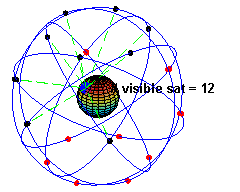

Hi,
I just bought a gt31.
When it is lying on a table it shows a speed between 0.2 and 5 km/h.
It should show 0, because it is not moving.
Is the unit broken? (it is brand new!)
Is it a setting?
Wkr
Werner
With those numbers we can quite safely say your GPS is working as it should!
Without going into explict detail, your GPS is hunting & seeing the grid as designed.
Maybe some tech person will fill in the details, however there is plenty of info out there.
It is normal to see changing very low speeds when the unit is stationary. If the unit has good reception of more than 5 satellites, outdoors with few obstructions that can cause radio signal reflection referred to as multipathing, (as exists when sailing), you should see speeds of less than 0.05 knots most of the time. A lot of work was done by our technical experts where testing was done with stationary units to pin down the actual error in the Doppler speed data. The short answer is that these small variations mostly cancel each other out over a number of recorded data points. Inside a house on a table is probably a poor environment for best accuracy.
Thank you the replies so far.
Indeed, it was lying inside our house on the table.
Outdoor it reports about 0.1 to 1.0 km/h when not moving.
Still, it's very strange for me, I also have a Garmin GPS, which knows exactly when I'm not moving...
We are going to use it for snowboard (max) speed measuring, how can we be sure the max speed will be correct?
Last year the winner had 100.4km/h and the second one 100.1km/h, measured with the same GPS. If there is a deviation of about 0.5, they will "fight" the measured results ...
The other problem is the time taken for a doppler reading is only a small fraction of a second, in the GT31's case this happens once a second.
I don't know anything about snowboarding, but a windsurfers speed can vary by that amount over a second.
So even if each sample is 100% accurate, there will still be differences in the instantaneous results.
We use a 2sec result that is the average of 3 readings, probably doesn't eliminate all errors, but it's a lot better than one reading.
There are a few programs that calculate the 2sec average. A free online service is here.
www.ka72.com/
Some models of gps, probably like your Garmin, have a 'filter' that guesses when the GPS is not moving and reports zero speed regardless of what the calculations are reporting.
The GT-31 is by far the most accurate of the consumer grade GPS for measuring speed. We have (very conservatively) better than 0.07 knots accuracy with 99% certainty. There is also internal data accuracy reporting that can indicate when the data is reliable or not. These are some of the reasons it has been selected by the GPS-Speedsurfing records committee for its world record ratification.
If you are interested in some technical papers on the accuracy of the GT-31 speed data, PM me and I can send you some links.
In all speed measurement there is some margin for error that must be allowed for when making measurements. You must understand what this is and have a system to deal with it. If you read the Record Rules on the GPS-Speedsurfing website you will get some insight into how we account for this and protect against erors (eg: using two GT-31 and ensuring that the results from each match within the expected maximum error margin.)
Also note that a single data point speed is the worst case for accuracy. When you take more points over a period of time (we use 10 seconds for our main rankings) accuracy increases dramatically.
The fact that it doesn't read zero, has a lot to do with:
- the earth is rotating, thus so is the GPS.
- the satellites are moving/flying in orbit, aka they are moving relative to the GPS
- atmospheric and gravitational effects can affect the signal propagation from the satellite to the GPS.
You need to keep in mind that your GPS is moving, not the satellites, as the earth rotates. The GPS has trouble calculating the speed as your movement is in 3D and it is trying to convert the calculated result to to 2D. What you are seeing is the margin of error in that calculation. As you get more satellites in view the error will reduce, the GPS has more points to triangulate its position from. It has long been known that the Sirf chipsets operate internally at 10 Hz but don't have the computational power to output data at that rate without overloading the system and increasing the margin of error. The U-Blox and Venus chipsets are capable of it and do output the necessary binary data.
What I should have said Matt is the GPS is moving relative to the satellites position as the earth rotates upon which your GPS is located while the satellites are in space, not in a geo-sync orbit but repeating the same ground track twice each day. I nominate you for today's pedantic award, let me know which address to send it to!
A nice visualization

A visual example of the GPS constellation in motion with the Earth rotating. Notice how the number of satellites in view from a given point on the Earth's surface, in this example at 45?N, changes with time.
from Matt's Wikimedia link
am no science nut but every connection the gps is to is moving. Satellites even on a prescribed axis with the earth erratically moves for sure..so does wave signals and the unit itself plus the earth. Put this all together and getting it to be precise I think is out of the question unless the gps unit is programmed strong enough to calculate errors and do an average but that still isn't precise
OK, here's another question. If the sirf chip runs at 10hz, then a 1sec result is actually that, a 1sec average, not an instantaneous speed.
So why do we need the average of 3 readings to get a 2sec average?